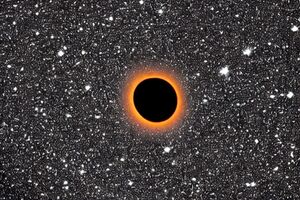Black Hole
A black hole is a region of spacetime with extremely strong gravitational forces, from which nothing, not even light, can escape. This wiki page provides an overview of black holes, including their formation, characteristics, and significance in astrophysics.
Definition and Characteristics
A black hole is formed when a massive star collapses under its own gravity, compressing its mass into an infinitely dense point called a singularity. The gravitational pull near the singularity becomes so intense that nothing, not even light, can escape its gravitational field. This phenomenon is known as the event horizon.
Key characteristics of black holes include:
- Singularity: The singularity is a point of infinite density at the centre of a black hole where the laws of physics break down. It is surrounded by the event horizon, beyond which no information or particles can escape.
- Event Horizon: The event horizon is the boundary of a black hole beyond which the gravitational pull is too strong for anything to escape, including light. Once an object crosses the event horizon, it is said to be inside the black hole and cannot return.
- Mass and Spin: Black holes have mass and angular momentum (spin). The mass of a black hole is determined by the amount of matter that collapsed into it during its formation.
- Size and Shape: Black holes are described by their size, which is determined by the mass they contain. The size is defined by the radius of the event horizon, known as the Schwarzschild radius.
Formation
Black holes are formed through the collapse of massive stars or through the mergers of existing black holes. When a massive star exhausts its nuclear fuel, it can no longer sustain the outward pressure of fusion reactions, leading to gravitational collapse. This collapse causes the star to become a black hole.
Another way black holes can form is through the merger of two compact objects, such as neutron stars or black holes. When these objects come close together, their gravitational attraction causes them to spiral inward and eventually merge, resulting in the formation of a more massive black hole.
Observations and Detection
Black holes cannot be directly observed because light cannot escape their gravitational pull. However, their presence can be inferred through various indirect observations, including:
- Effects on Surrounding Matter: The intense gravitational forces of a black hole can cause visible effects on surrounding matter, such as the emission of X-rays and the formation of accretion disks. These observations provide evidence of the presence of a black hole.
- Gravitational Waves: The merger of black holes can generate gravitational waves, ripples in spacetime. Advanced gravitational wave detectors, such as LIGO and Virgo, have detected the signals from merging black holes, confirming their existence.
Significance in Astrophysics
Black holes have profound implications for our understanding of astrophysics and the nature of spacetime. They contribute to:
- General Relativity: Black holes are a consequence of Einstein's theory of general relativity. The study of black holes helps test and refine our understanding of the fundamental laws of physics.
- Galactic Evolution: Black holes play a crucial role in the formation and evolution of galaxies. They influence the dynamics of galactic structures and can shape the distribution of matter in their vicinity.
- Cosmology: Studying black holes provides insights into the nature of the early universe, the growth of galaxies, and the formation of large-scale structures in the cosmos.

